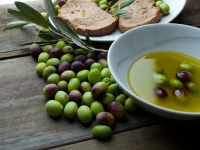Olea europaea
| See Also | Botanical Monographs |
|---|
Olive (Olea europaea) is an evergreen tree that can reach heights of 30 ft. The gray-colored trunk is heavily grooved and the leaves are small and "leathery." Olive flowers are greenish-white clusters and the well-known fruit is green and only turns black when ripe. To explore the characteristics, medicinal uses and prescribing considerations of this herb in more detail, check out the references indicated.[1], [2]
Contents
Characteristics
- Common Names: Olive, olive tree, olivier
- Family: Oleaceae
- Habitat: Olea is found in Southern Europe in the Mediterranean where it is found in the wild and is cultivated. It can also be found in North Africa, the Middle East and is now cultivated around the world.
- Parts Used: Leaves and oil. The pickled fruit is also eaten as a food.
- Constituents:
- Leaves: Iridoid monoterpenes (6-9% oleoropine, oleoroside, oleoside, etc.), triterpenes (oleanolic acid, maslinic acid, etc.), flavonoids, chalcones, oleasterol, leine.
- Oil: Mono-unsaturated fatty acids (56-83% oleic acid, 8-20% palmitic acid, 4-20% linoleic acid, etc.), 0.125-0.25% steroidal compounds, tocopherols.
- Mono-unsaturated fats reduce low-density lipoprotein (LDL) cholesterol that normally deposits in the arteries. They also do not deplete the high-density lipoproteins (HDL) which deposit cholesterol in the liver to be broken down.
- Fruits: Many of the same as the oil, but also some protein and many vitamins and minerals: vitamin E, many B vitamins, beta-carotene, zinc, copper, iron, calcium, magnesium, and phosphorous. Olives are also high in sodium.
- Medicinal Actions:
- Leaves: hypotensive, circulatory tonic, cardiac tonic, mild diuretic, astringent, antimicrobial, febrifuge, antioxidant, radioprotective, antipyretic,
- Oil: demulcent, emollient, cholesterol lowering, antineoplastic, mild laxative, hepatic, cholagogue
Uses
Historical Uses:
The oil from Olea europea has been used in the Mediterranean for infants who were weak. The infants were bathed in the olive oil and wrapped to increase vitality. There are also reports that the leaves were used as a tea and for curing malaria.
Medicinal Uses
Oil
- constipation in children or adults, with rectal fissures, ulcers (inject rectally)
- colitis, flatulence, gastrointestinal ulcers, gastrointestinal irritations, wrong substance swallowed (take several Tbsp orally or warm and inject rectally), dysentery (inject rectally or take orally),
- appendicitis - take every hour and keep the abdomen warm
- cholelithiasis: 25-50mL and 8oz of grapefruit juice for 3 nights, repeat in 3 weeks or 180-360mL three to four times daily
- causes spasm of Gallbladder to release stones, useful for sludge but not large stones
- stones that are released are saponification of olive oil (if they dissolve at room temperature)
- foods that increase risk of gallstones include: eggs, dairy, pork, corn, onion/garlic (especially if a food sensitivity exists)
- poisoning from caustic substances, alkali substances - take orally (several Tbsp) to coat and protect the esophagus and stomach
- decreases atherosclerosis/arteriosclerosis (Cultures that consume olive oil as their primary cooking oil have lower incidents of heart disease), decreases cholesterol, cardioprotective, increases HDL, increases coronary artery blood flow, decreases coronary artery spasm, arrhythmia
- Other Conditions
- diabetes mellitus
- rheumatism and gout
- preventive for breast cancer - based on studies of decreased incidence with increase olive oil intake
Fruit
- Conditions
- diarrhea
- bloody sputum
Leaf
- hypertension (labile or moderate): moderate effect in rats, excellent effect in cats
Olive Leaf Extract
- malaria, malarial fever, chills, diarrhea
- severe viral infections with fever and chills, bacterial infections (esp. flu, herpes, or infections of the gut or respiratory system)
Prescribing Considerations
The information provided is intended to augment the treatment from a naturopathic doctor or other trained medical professional. Although most herbs are generally safe, it is recommended that you avoid self-prescribing especially when there is an underlying ongoing medical condition, if you are on any prescription medications or if you are pregnant or breastfeeding.
Formulations and Preparation
Oil from Fruit
Leaf
-
- Malaria - 'wineglassful' of strong leaf decoction every 3 hours
- Infusion - 2 tsp/cup or 7-8g three to four times daily
- Leaf extract - 500mg every 6 hours for 3 days or until better
Olive Leaf Extract
- Capsule - 60-500mg capsule every 6 hours until better for 2-3 days; follow with Lactobacillus acidophilus, Lactobacillus bifidus (probiotics)
Safety
The safety and prescribing considerations for this herb include:[3] [4]
- Generally regarded as safe.
- Side-effects are generally not seen but can cause GI irritation so take before meals (the olive leaf extract).
- Cautions and Contraindications: the oil of the fruit is contraindicated with gallstones, the oil is an irritant to the eyes and conjunctiva (empirical)
- Drug-Herb Interactions are rare.[2]
- Hypoglycemic Drugs - leaves have hypoglycemic action therefore may have an additive effect
- Anticoagulants - oil is a platelet aggregation inhibitor therefore may modify the effects of the drug
References
- ↑ Boon Heather, Smith Michael (2009) 55 Most Common Medicinal Herbs: The Complete Natural Medicine Guide Second Edition Institute of Naturopathic Education and Research, CCNM Toronto.
- ↑ 2.0 2.1 Godfrey Anthony, Saunders Paul, Barlow Kerry, Gowan Matt (2011) Principles and Practices of Naturopathic Botanical Medicine, Advanced Botanical Medicine. V3 CCNM Press, Toronto.
- ↑ Stargrove Mitchell Bebell, Treasure Jonathan, McKee Dwight L (2008) Herb, Nutrient and Drug Interactions: Clinical Implications and Therapeutic Strategies.
- ↑ Brinker Francis (1997) Herbal Contraindications and Drug Interactions: Plus Herbal Adjuncts With Medicines, 4th Edition Eclectic Medical Publications.
